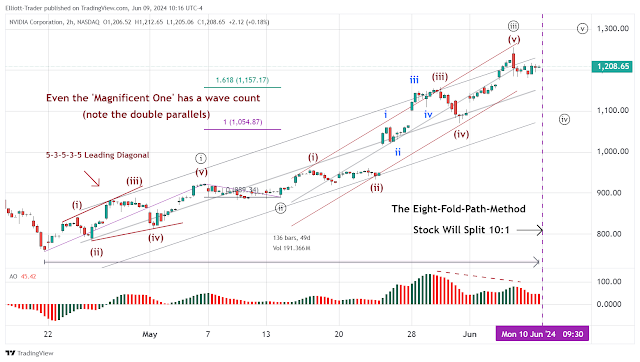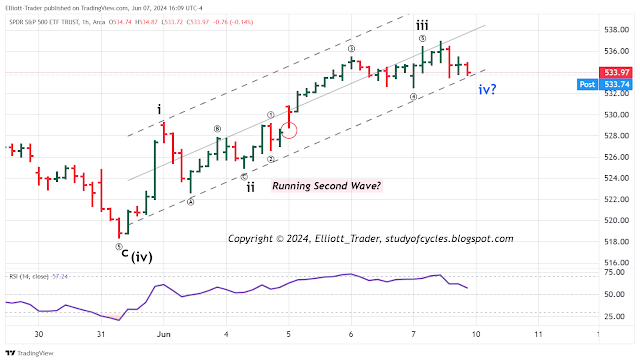Purpose
The purpose of this site is to count the Elliott Wave following a 'rules-based' approach and to utilize it to assist in marking market turning points (highs and lows) to the extent possible.
Not Purpose
This blog is specifically not a 'trading' blog. Topics such as "how much money you made on buying or selling you name it .." are not welcome here and do not belong here. Strategies for how to make money, such as 'which options to buy or sell, which stocks to buy or sell, etc.' are also not welcome at this site. Again, the topic is counting the Elliott Wave. Stick to the topic or please do not post comments here.
This blog is also not about fundamental analysis (GDP, company news announcements, etc.) except as may be specifically related to a particular wave count.
Key Ideas
One
A rules-based approach to Elliott Wave analysis can be utilized to help identify market turning points. One key rules-based approach we have suggested is linked below. It is The Eight-Fold-Path Method for Counting an Impulse Wave.
The Eight-Fold-Path-Method for Counting an Impulse
The above post was the "Featured Post" on this Site for over a Fibonacci eight (8) years before being replaced by this one. It is still central to understanding this blog.
Two
A second key-idea relates to the fact that a number of trading algorithms - rightly or wrongly - help create market turns by adhering to technical indicators other than the Elliott Wave. One most notable is the daily, weekly (and sometimes intraday) Bollinger Bands. And, because we do care about finding turning points - and even trading in the final analysis - we have posted another rules-based approach which we have paraphrased from broker Ira Epstein as in his publicly available videos. It is based on Bollinger Bands and momentum. You can find that approach below.
Paraphrase of Ira Epstein's Rules for Trading
But, again, even though we care about trading and do trade ourselves, we don't outline trades taken via Ira's methods or not. This is again because this site is about counting the Elliott Wave - not about following Ira's system. If a person wishes to do that - they are free to generate their own charts based on his system and proceed as such. We often do it ourselves. Further, we note that many distinguished mathematicians (Mandlebrot, Taleb) have argued that stock market movements are not normally distributed (do not follow Bell-Curve statistics which the Bollinger Bands are based on). So, such an identified turning point often has a chance of being accurate, but not necessarily. And this is an argument against this approach.
Three
Even though rules-based approaches are helpful, wave-counting is still a probability exercise in which wave counters and traders try to assess their best odds for a correct count or a correct trade. To that extent, we have again elaborated a bit on what we mean in this post.
Snake Oil or Not? : Probability In Wave Counting
Four
No one said wave trading was easy. It is prone to mistakes. Glen Neely has summarized The Five Most Common Mistakes that Elliott analysts often make. The full audio interview appears at this LINK. But our paraphrase of it appears in this blog post.
The Five Most Common Mistakes Elliott Analysts Make
Five
Based somewhat on the above summary of mistakes, we have posted what we think is the largest mistake professional Elliott analysts have made in counting the up wave since the depression. This appears below.
The Largest Single Mistake Most Analysts Have Made
Respect
Because we recognize that market returns are to some-extent a game of "odds", people who comment on this blog are to respect each other. No one person, no firm, no wave counter, no trader ever has a perfect assessment of the odds. And, as a result, there is no perfect trade. If you got the direction right, your trade size wasn't large enough. Otherwise, you'd be rich and flying to the Turks in your private jet; not reading this blog. And if your trade size is too large you risk being ruined by getting the direction wrong. So, be as kind to each other as possible within the context of this blog. We are all fallible. We always will be. We are a biological entity. And sometimes these have neuronal, hormonal and other glitches that cause us to be incorrect or have faulty expectations. Please recognize this for all including the blog moderator.
Free Site
Unlike many other wave-counting-sites that try to extract money from you for the privilege of reading, or the privilege of counting to five, this site specifically does not. For this reason, it is easy to be a reader of this site. It is a bit more difficult to be the moderator. We try in every possible way to keep this site open for commenting with regard to the Elliott Wave. BUT, commenting for your own website promotion, for your own ego gratification, or to the detriment of this blog simply won't be tolerated. And the moderator reserves the right to remove any post, to call out those who are not following the ground-rules, to report harassment to the blog operators, or to discontinue comments at any time in order to maintain the purpose of the blog.
Links
There are two easy ways to post Elliott Wave ideas on this blog. The first is use a free charting service like Investing.com, TradingView.com or Barchart.com and use their link feature to post a chart via their link. We often do this and find it most convenient. The second way is to use a free photo site (like Flickr, etc,) to save your chart as a picture and then post a link to the picture/chart from that site. The blog moderator has no vested interest in any of these sites, other than he may be a user at times.
Prohibited Links
Once again, you may not post a link to your own website if you request payment or donations from others. Further, you may not post links to other paid websites. An occasional link to a reputable news site regarding a matter that may have technical relevance (Bloomberg, CNBC, CNN, ZeroHedge, etc.) is acceptable. The moderator may occasionally post a link to a paid site (McClellan Financial, Elliott Wave Intl, etc.) if directly related to the topic at hand, but it is not in any way an endorsement of same nor a statement as to the quality of the analysis provided.
Disclaimer
Nothing in this blog is to be taken as trading or investment advice. The moderator is not a financial advisor. Nothing within the blog or its contents is to be taken as a solicitation to buy, sell or hold any stock, bond, option, or financial instrument or contract of any type. By reading this blog, you recognize that trading or investing can be risky endeavors and cause a loss of some or all of your capital. Further, you agree that any gains or losses you incur are the sole result of your decisions and agree to hold this blog and its moderator free from any claim to the contrary. All information published by the moderator is the sole property of the moderator. It may not be copied or transmitted in any matter without the specific consent of the moderator.
We hope you will join us freely in an experience in wave-counting without distracting from it by lack of adherence to these simple ground rules.
Thanks, and enjoy.
TraderJoe

%202024_26%20(8_04_27%20PM)%20Analysis.png)






%202024_06_21%20(5_55_58%20PM).png)
%202024_06_20%20(6_18_16%20PM)%20Post.png)
%202024_06_19%20(10_40_16%20AM)%20Experimental.png)














